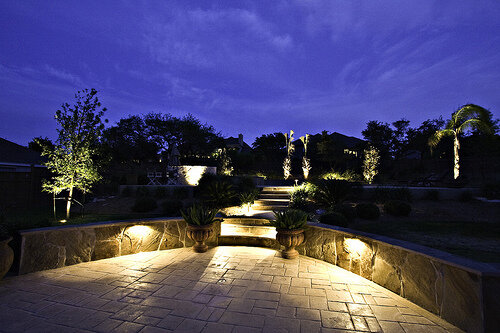Make Your Landscape Glow
Whether you do landscape lighting yourself or hire a professional, it is important to understand how best to create a glowing landscape
There is so much to know about effective landscape lighting. The objective is not to create complete and continuous illumination. Good lighting should provide safety after dark as well as create ambience and highlight features. It is not necessary to do all of that but you do need to evaluate how you use your landscape spaces and how to enhance favorite features. Note that the fixture housing will determine how light is cast by focusing and shaping the light.
Types of Lighting
Standard voltage lights at entry doors or property entrance post lights are bright and make navigation in and out safe and easy.
Low voltage lighting is dimmer than standard voltage to create a soft glow
Solar lighting is a very easy and inexpensive way to add a subtle glow to walkways or gardens. Light output is pretty low but these lights are improving. Solar lights use a rechargeable battery and must be installed in sunlight for charging.
Battery powered lights are also a very easy and inexpensive way to add more targeted lighting to your landscape. LED lights in pathway, step and spot lights produce enough light for safety. Motion sensors will preserve the life of the batteries but will likely need replacement every year or two depending on frequency of use.
LED bulbs for low voltage lighting can be very pricey but they pay off in many ways. They will last as long as 20 years but a halogen will only last 2 years. LED bulb only pull up to 10 or 11 watts of power but halogen can pull as much as 60 watts. The low wattage allows for smaller less expensive transformers and cable. Be sure to get the warm color temperature, 3,000 K, and high lumen output to approach the brightness of halogen.
Types of Lights
Spot lights are bright and can be directed to highlight features or simply provide bright illumination for safety. The light housing can be swiveled as needed. Security spots can be motion activated.
Standard lantern lights are used for broad general lighting.
Path light shades project wide downward lighting to illuminate walkways.
Rope or string lights can be strung from structures and trees to create a fun ambience for an entertainment area. These can be wired into your porch light, plugged in or battery powered.
Brick lights can be installed with pavers or in the ground along pathways creating soft up lighting.
Deck lights can be built in or attached to rail posts to provide a wash of downward lighting. Small lights can be attached to or recessed in stairs to illuminate steps for safety.
Techniques
A very inexpensive option to add ambience to a porch or patio is simply to install a dimmer to your standard entry light. The light is easily softened for entertaining.
Keep lights from shining in your eyes by installing lights 2 feet or less from the ground and overhead lighting 7 feet or more from the ground.
Use 2 foot high path lights with downward light canopies spread light to illuminate pathways. The light fixture style and finish is also a decorative accent even when not nlit.
Under lighting a tree with a spot pointed straight up the trunk creates a very dramatic silhouette.
Silhouetting a tree or garden structure can also be accomplished with an upward facing spots. A small 20 foot tree will only need one but ideally two low watt lights. Larger trees may need as many as five 50 watt lights to adequately illuminate the canopy.
A spot placed high up in a tree’s branches will cast fascinating light and shadows to the surrounding area.
Wide spreading wash lights can be used along the house front with upward bullet spots at the corners or entry pillars.
Use wide spread lighting about 20 feet apart to wash over garden beds. Lights of course need to be taller than the foliage to achieve a soft wash over the garden. Taller shrubbery can be washed from above.
Large focal point features such as a fountain should be highlighted with at least two lights to reduce harsh shadows.
So now, think about what you want to accomplish and how you can do it armed with some outdoor lighting knowledge.
Highlight architectural features
Highlight garden features or structures
Wash an interesting tree form with light
Create inviting ambience for entertaining
Don’t forget lighting for grilling
Low broad spread lighting casts a soft glow for patio dining
Down lightinghighlights interesting tree structure
Broad downward light washes light over planting beds
Downward broad lighting creates safety on walkways, small trees are highighted with upward spots
String lights add easy festive ambiance for entertaining
Light housing with cut glass creats light and shadows especially in winter
Light up deck stairs with motion sensored spots
Light garden beds with high mounted spots
A combination of lighting creates a soft glow over large structure areas
Highlight special features with low broadcast lighting and broad washing overhead lights
Combine soft lighting broad washing walkways, gardens and structures for an overall soft glow
Solar lighting casts minimal light but is easy and inexpensive
Use upward spotlights to accent focal points
Several upturned spotlights wash over facades














